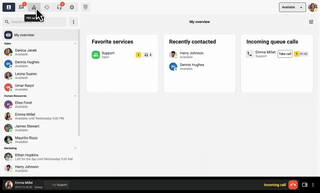Today, many of us work from home and it has become an increasingly accepted part of our working lives. But how can we be more productive when we work from the couch? A lot depends on the IT solution. Here we tell you what tools your IT solution should have!
Changing conditions for teleworking
When Statistics Sweden presented new statistics at the end of 2020, it turned out that one in three Swedes worked from home at least one day a week. Of course, the upward trend in teleworking is largely due to the coronavirus pandemic that hit the world in 2020. Many companies that had the opportunity to adapt chose to allow their employees to work from home. While many were forced into a new way of working, it led to a greater understanding not only of other people and the need to work together to stop the spread of the virus – but also of the strengths of teleworking.
As expected, Swedes and the Internet 2020 also shows a huge increase in remote work from home. Before the pandemic, only just over 2% of full-time workers worked from home for the majority of their working day. Today, this figure has increased to 23%, which is more than a tenfold increase. We can also see that 83% of all those who have worked from home say that it has been very or fairly successful. The fact that working remotely has worked well for the vast majority is clear as 9 out of 10 who worked at home during the pandemic want to continue doing so in the future.
Better results and health benefits with teleworking
Many studies on teleworking show that it increases productivity while reducing stress. It saves the environment, increases employee loyalty and makes it easier to maintain a better work-life balance. It creates the conditions for flexibility, which also generally makes employees feel much better. It also provides scope to attract talent from the other side of the globe.
A common concern among employers has been that teleworking from home will cause them to lose control over how employees work. Traditionally, employers have kept track of the time employees spend at work. When it comes to teleworking, the focus should instead be on what is done during working hours.
The result achieved is also a better metric than the number of hours in the office. Therefore, managers need to be able to set clear goals and define the purpose of why employees should work remotely. Crystallized goals allow for greater development potential for both the individual and the company as a whole.
In the unlikely event that you need even more answers as to why teleworking is the new black, read about 6 reasons why your company should start teleworking.
The success of remote work depends a lot on the IT solution
Many people find that when they need peace and quiet to perform a certain type of task that requires high concentration, remote work from home is superior. Moreover, since the pandemic, we know that working from home is great if you feel unwell but still feel well enough to work.
A study by Owl Labs found that 16% of companies worldwide allow their employees to work fully remotely. Companies like Spotify now allow all their employees to work remotely and instead work at home, in a coffee shop or from their summer cottage. But being able to work effectively remotely depends a lot on the employer’s IT solution, otherwise the benefits may not be realized if the technology is not up to scratch.
4 features your IT solution should have
1. chat – so you can easily stay in touch
Chat is a perfect tool for working remotely. It makes it easy to send short messages and get quick replies. You can chat one-on-one or in chat groups. At Telavox, for example, we have created a chat room for all employees where they can get information about company news.

2. Video meetings
For remote working from home to work as smoothly as possible, most people will sometimes need digital meetings. Of those who worked from home in 2020, 9 out of 10 had digital video meetings – and even 9 out of 10 think these meetings worked very or fairly well.
With Telavox video conferencing, you can easily organize internal and external meetings without hassle. Together with colleagues, you can get started right away in our chat feature. If you need a link to invite to an external meeting, just copy a URL and paste it from the switchboard view.
3. mobile app for when you’re on the go
The best teleconferencing is accessible, easy to use and creates better collaboration within the company. If you’re using mobile, you usually only need one app. Here you simply create an invitation to the conference and then send out the code to participants. You can call directly into the app, via a landline or other mobile phone – you don’t even have to use your own phone.
4. Smart profiles – keep track of colleagues’ availability
In Telavox, we use profiles that allow you to tell your colleagues where you are in a relevant way. They can then quickly see if you are sitting at home in your apartment and working, if you are at a yoga class or at a lunch meeting.
Executive summary
Of course, not all industries can apply teleworking. But if the opportunity exists, there are now digital tools that make it easy to work wherever you are and deliver at least as high quality as in the office.
There are plenty of digital tools available today that your team can use. Smart digital tools are essential if you want to achieve successful remote working, so if you want to help your employees work more effectively from home, you should take a closer look at some of these.
Telavox has the platform to simplify your business communication – both with colleagues and with customers. Contact us and we’ll tell you more!


